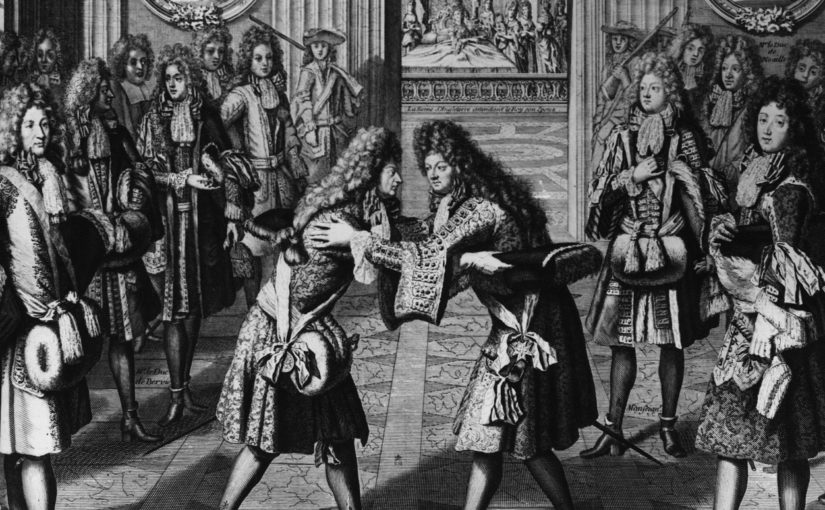The discourse the Chevalier Ramsay made in Paris in 1736 could have just been a speech of circumstance which, as it is the fate of many speeches of a circumstantial nature, would have then fallen into oblivion. Instead it has been held in high regard ever since, been translated and successfully published in many foreign languages. But more importantly, it still provides the fundaments on which French Freemasonry rests.
WHO WAS THE CHEVALIER RAMSAY?
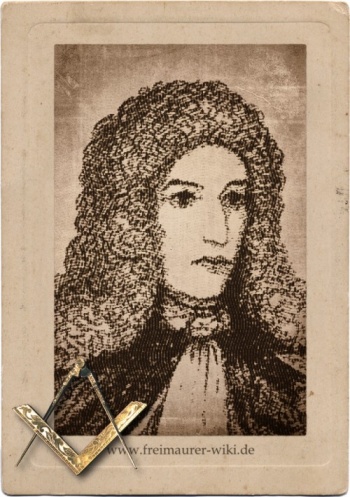 Destined to become one of the most romantic figures in the history of Freemasonry, Andrew Michael Ramsay was born in Ayr, Scotland, on June 9th 1686. He entered Edinburgh University at the age of 14 and studied classics, maths, theology and on finishing his studies he took up the position of tutor in the Earl of Wemyss’[1] household. In 1706 Ramsay left England for the Flanders where he joined the army of the Duke of Marlborough who was engaged in the war of the Spanish succession, essentially a war between France and Spain against England and Austria. In 1710 he met the Archbishop of Cambrai, Fenelon, and became his companion until Fenelon’s death in 1715. Born a Calvinist[2] Ramsay converted to the Roman Catholic faith under the teaching of his Church Official friend. Ramsay then moved to Paris where he worked for the Duc de Chateau-Tierry who introduced him to the Regent, Philippe d’Orleans, brother of King Louis XIV. The Prince was also the Grand Master of the Order of Lazarus[3] so that through that acquaintance Ramsay was able to be admitted in his Order which henceforth qualified him to be known as the Chevalier de Ramsay and to receive a pension from the Abbey of Signy.
Destined to become one of the most romantic figures in the history of Freemasonry, Andrew Michael Ramsay was born in Ayr, Scotland, on June 9th 1686. He entered Edinburgh University at the age of 14 and studied classics, maths, theology and on finishing his studies he took up the position of tutor in the Earl of Wemyss’[1] household. In 1706 Ramsay left England for the Flanders where he joined the army of the Duke of Marlborough who was engaged in the war of the Spanish succession, essentially a war between France and Spain against England and Austria. In 1710 he met the Archbishop of Cambrai, Fenelon, and became his companion until Fenelon’s death in 1715. Born a Calvinist[2] Ramsay converted to the Roman Catholic faith under the teaching of his Church Official friend. Ramsay then moved to Paris where he worked for the Duc de Chateau-Tierry who introduced him to the Regent, Philippe d’Orleans, brother of King Louis XIV. The Prince was also the Grand Master of the Order of Lazarus[3] so that through that acquaintance Ramsay was able to be admitted in his Order which henceforth qualified him to be known as the Chevalier de Ramsay and to receive a pension from the Abbey of Signy.
In 1723 Ramsay became tutor in Rome to the two young sons of the Old Pretender, the catholic James Francis Edward Stuart (James III), who had fled 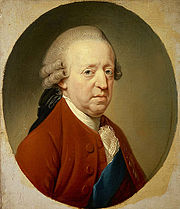 England after losing the crown to the protestant Prince William of Orange. From 1725 to 1728, Ramsay stayed as an invited guest of the Duc de Sully and it was during this period he wrote the famous novel The Travels of Cyrus which was published in 1727. It was a best seller in its day and served to establish the Chevalier’s reputation in England as well as on the Continent.
England after losing the crown to the protestant Prince William of Orange. From 1725 to 1728, Ramsay stayed as an invited guest of the Duc de Sully and it was during this period he wrote the famous novel The Travels of Cyrus which was published in 1727. It was a best seller in its day and served to establish the Chevalier’s reputation in England as well as on the Continent.
In 1728 Ramsay travelled to London and soon after he went to Scotland where he was the guest of the Duke of Argyle at Inverery. Then on to Oxford as the guest of the Marquis d’Abais. The following year he joined the Gentlemen‘s Society of Spalding[4], made up in grand part of prominent freemasons such as Sir Isaac Newton, Alexander Pope and Dr John Desaguliers. Ramsay himself never said when he joined our Order but it is reasonable to assume he was probably initiated in the Craft by one or more members of that Society and that it occurred, as reported by the London Evening Post 17 March 1729, at the Horn Lodge in the Palace Yard, Westminster, with his Grace the Duke of Richmond in the Master’s Chair. Ramsay was also known to be a member of the Lodge “Louis l’Argent” which was established in Paris under a warrant from the Grand Lodge of England.
Whilst in Oxford Ramsay joined St Mary’s Hall and in 1729 was conferred a degree of Doctor of Civil Law (D.C.L.), thus becoming the first ever Roman Catholic subject to have been granted the honour since the Reformation. In 1730 Ramsay returned to Paris and entered the service of the Comte d’Evreux of the Tour d’Avergne which had ties with the Jacobite Court. He retained a position in that family until 1741.
Since his return to France n 1730, Ramsay had became very active in Freemasonry and in 1736 he delivered the oration that made his name famous in the annals of the Craft. The speech was later published with the title “Relation apologique du Franc-Masonnerie” and was publicly burned in Rome by the order of the Pope.
Ramsay died on May 6 1743 at St. Germain-en-Laye where he was buried; later his heart was removed and transferred to the Benedictine nunnery of St. Sacrement in Paris.
RAMSAY’S DISCOURSE
For Ramsay a freemason must aim to fulfil two ambitious duties. He must:
– be fully involved in the world that surrounds him and to strive to change it
– embark on the pathway of symbolism and of initiation for a spiritual advancement
The following are extracts from his discourse:
“Mankind is not essentially differentiated by the tongues spoken, the clothes worn, the lands occupied or the dignities with which it is invested. The world is nothing but a huge republic, of which every nation is a family, every individual a child. Our society was at the outset established to revive and spread these essential maxims borrowed from the nature of man.
We desire to reunite all men of enlightened minds, gentle manners and agreeable wit, not only by a love of the fine arts but, much more, by the principles of virtue, science and religion where the interests of the Fraternity shall become those of the whole human race (…) where the subjects of all kingdoms shall learn to cherish one another without renouncing their own country.”
“Our ancestors, the Crusaders, 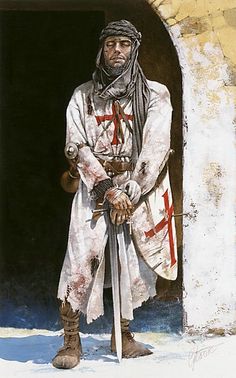 gathered together from all parts of Christendom in the Holy Land, desired thus to reunite into one sole Fraternity the individuals of al nations. (…) these superior men, without gross selfish interest, without even listening to the inborn tendency to dominate, imagined such an institution, whose sole aim is to unite minds and hearts in order to make them better (…)”
gathered together from all parts of Christendom in the Holy Land, desired thus to reunite into one sole Fraternity the individuals of al nations. (…) these superior men, without gross selfish interest, without even listening to the inborn tendency to dominate, imagined such an institution, whose sole aim is to unite minds and hearts in order to make them better (…)”
(…) The second requisite of our Society is sound morals.
(Whilst) the religious orders where established to make perfect Christians and the military orders to inspire a love of true glory, the order of the Freemason is to make lovable men , good citizens, good subjects, inviolable in their promises , faithful adorers of the God of Love, lovers rather of virtue than of reward”.
In other words , should they be needed after such a clear postulation , a freemason must learn to be a virtuous man, moderate in his thoughts and costumes and sociable. He must learn to avoid conflicts and excesses so as to find more time to study that which ennobles the human condition: the Arts and the Sciences. And the Lodges are the right peaceful places where to harmoniously perfect ourselves.
But after these moral and philosophical considerations Ramsay also highlights the initiatic dimension of Freemasonry as he explains:
“(…) We also have our secrets: they are figurative signs and sacred words composing a language sometimes mute, sometimes very eloquent that we use to communicate with one another at the greatest distance, to recognise our Brothers of whatsoever tongue. (…)”
What is remarkable about this speech is that three centuries later this noble dimension is still a strong characteristic marking the Latin Freemasonry and the text is the foundation on which French Freemasonry’s tradition is based.
With regard to the noble nature of the original Freemasons, Ramsay says:
“(…) The word FM must not be taken in a literal (…) and material sense as if our founders had been simple workers in stone or merely curious geniuses who wanted to perfect the Arts. They were not only skilfull architects (…) but also religious and warrior Princes who designed, edified and protected the living Temples of the Most High. And (…) whilst they handled the trowel and mortar with one hand, in the other they held the sword and the buckler. Our order therefore must be considered as (…) an order founded in the antiquity, renewed in the Holy Land by our ancestors 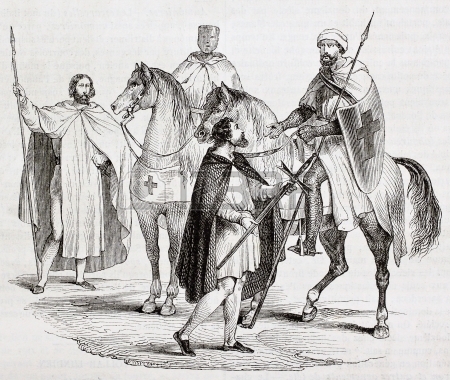 in order to recall the memory of the most sublime truths amidst the pleasures of the society. The Kings, Princes and Lords returned from Palestine to their own lands and there established divers Lodges. At the time of the last Crusade many Lodges were already erected in Germany, Italy, Spain, and France and from thence in Scotland, because of the close alliance between the French and the Scottish.
in order to recall the memory of the most sublime truths amidst the pleasures of the society. The Kings, Princes and Lords returned from Palestine to their own lands and there established divers Lodges. At the time of the last Crusade many Lodges were already erected in Germany, Italy, Spain, and France and from thence in Scotland, because of the close alliance between the French and the Scottish.
James Stuart of Scotland was Master of a Lodge at Kilwinning, in the west of Scotland in 1286, shortly after the death of Alexander III, King of Scotland (…)
After the deplorable mishaps of the Crusades (…) the great Prince Edward , son of Henry III, King of England (…) brought back the colony of his Brethren from the Holy Land into England(…) declared himself protector of the Order, conceded to it new privileges and then the members of this Fraternity took the name of Freemasons after the example of their ancestors.” Ramsay therefore clearly proclaims that Freemasonry was constituted by the Holy Land’s survivors of the Chivalric Order of the Middle Ages, in other words the Knights Templar.
But he also further states: “(..) the religious discords which embarrassed and tore Europe in the XVI century caused our Order to degenerate from the nobility of its origin. Many of our Rites and usages (…) were changed, disused ad suppressed (..) thus many of our Brothers forgot the spirit of our laws ad retained only the letter and shell”
WHAT TO MAKE OF IT ALL?
There are claims that Ramsay himself was the originator of the first series of the Templar Degrees. But although there is no evidence to substantiate this, Ramsay’s speech nevertheless possibly provided the inspiration for the foundation of the Royal Arch.
But besides from agreeing on the beauty of the contents, the statement on Freemasonry’s tenets, the historical embellishments and so forth that are present in the Chevalier’s speech I am keen to support the interpretations that the following two Masonic historians gave on Ramsay.
According to Rebold[5] in his “History of the Three Grand Lodges”, the Scotsman Ramsay was a staunch supporter of the House of Stuart and introduced a system of Freemasonry created at Edinburgh by a Chapter of the Kilwinning Lodge (to which the King belonged) in the interests of the Stuarts and with the final aim of submitting Freemasonry to Roman-Catholicism.
As to Kloss[6] , he says that Ramsay introduced on purpose the Higher Degrees so that he could make a selection from the ranks of the Brotherhood in the interest of the Stuarts and to collect funds from those new Lodges in favour of the Pretender who was preparing another attempt to regaining the British throne.
Had Ramsay succeeded in obtaining for his speech and Freemasonry the official endorsement of the Chief Minister to Louis XV – Cardinal de Fleury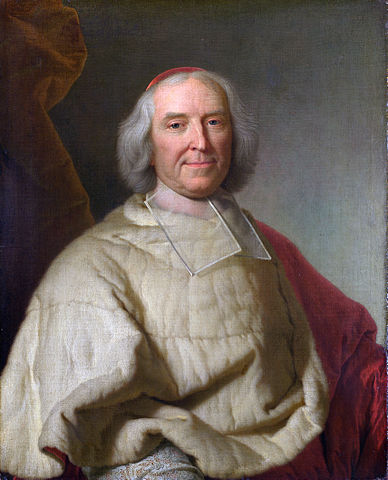 to whom Ramsay wrote on two occasions – he would have managed to give credibility to the Stuarts’s claim to the throne of England by proving France’s support. But this was wholly contrary to the Cardinal de Fleury’s policy which, instead, envisaged having peace with England and concentrating on restoring France’s internal economy and reducing its military interventions. The Cardinal, understandably, never replied to the Chevalier’s two letters and instead proceeded to interdict the Craft in France with an edict issued in 1738.
to whom Ramsay wrote on two occasions – he would have managed to give credibility to the Stuarts’s claim to the throne of England by proving France’s support. But this was wholly contrary to the Cardinal de Fleury’s policy which, instead, envisaged having peace with England and concentrating on restoring France’s internal economy and reducing its military interventions. The Cardinal, understandably, never replied to the Chevalier’s two letters and instead proceeded to interdict the Craft in France with an edict issued in 1738.
In conclusion and disappointing as it may be, this sight at the figure of the Chevalier de Ramsay, reveals that our Masonic hero was principally a Jacobite on a political Crusade!
By W.Bro. Leonardo Monno Anglisani – NHL 6557 Prov. of Middlesex, England
The author forbids any reproduction or publication of this article, in full or in part, without his explicit authorisation.
[1] David Wemyss (ca 1678-1720) was Grand Master of Scotland for 1743-1744 and from his lineage descended many other FM Grand Masters
[2] Calvinism: a form of Protestantism
[3] It was a powerful and extremely rich military and religious order founded in Jerusalem in the fourth century to take care of the lepers in Palestine, where they built Hospitals known as Lazzaretes.
[4] The Spalding Gentlemen’s Society was founded in 1710 and is one of the oldest learned societies in the kingdom and the earliest Provincial association for the encouragement of archaeology. It was founded by Maurice Johnson (1688 – 1755)
[5] Emmanuel Rebold : Histoire des Trois Grandes Loges de Francs-Maçons en France (Paris 1864,p.44)
[6] Geschichte der Freimaurerei in Frankreich (“History of Freemasonry in France,” 1852–53) by Georg Franz Burchard Kloss (Frankfurt 31.7.1787-10.01.1854)
- Pomegranate in Freemasonry – its significance - March 11, 2024
- Inns and Innkeepers’ incidence in Freemasonry expansion - February 28, 2024
- The Black Queen of England - January 15, 2024

